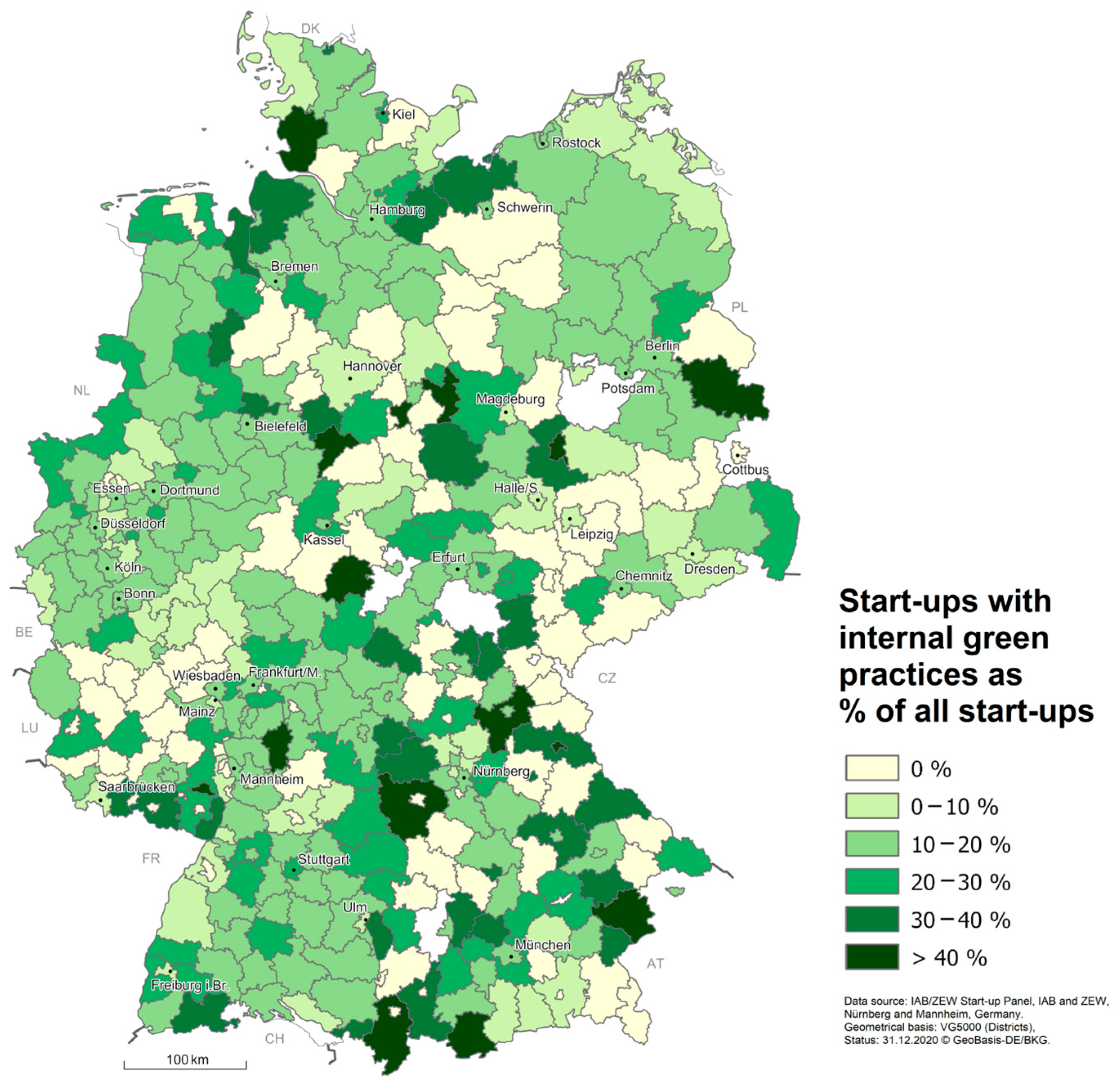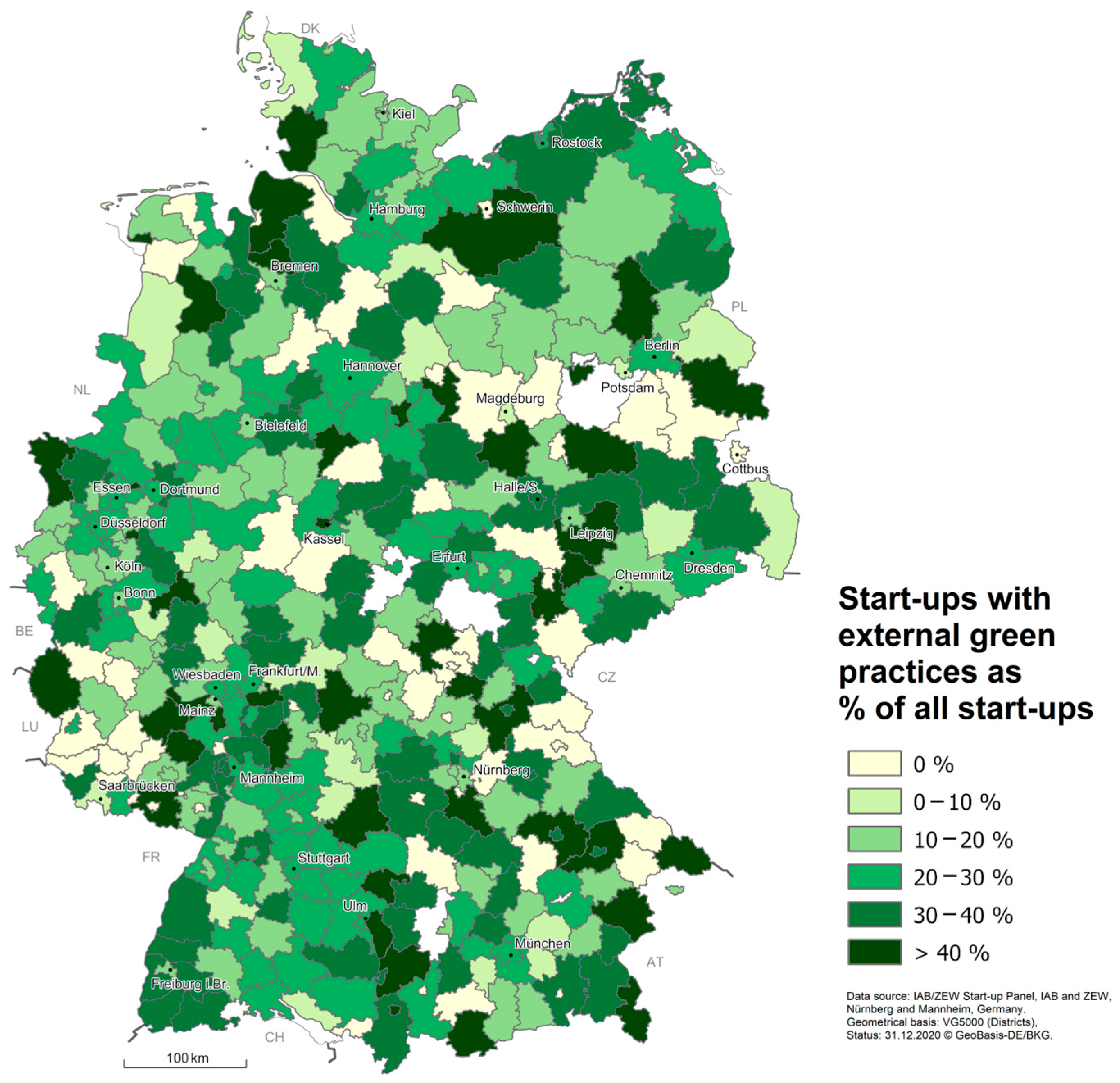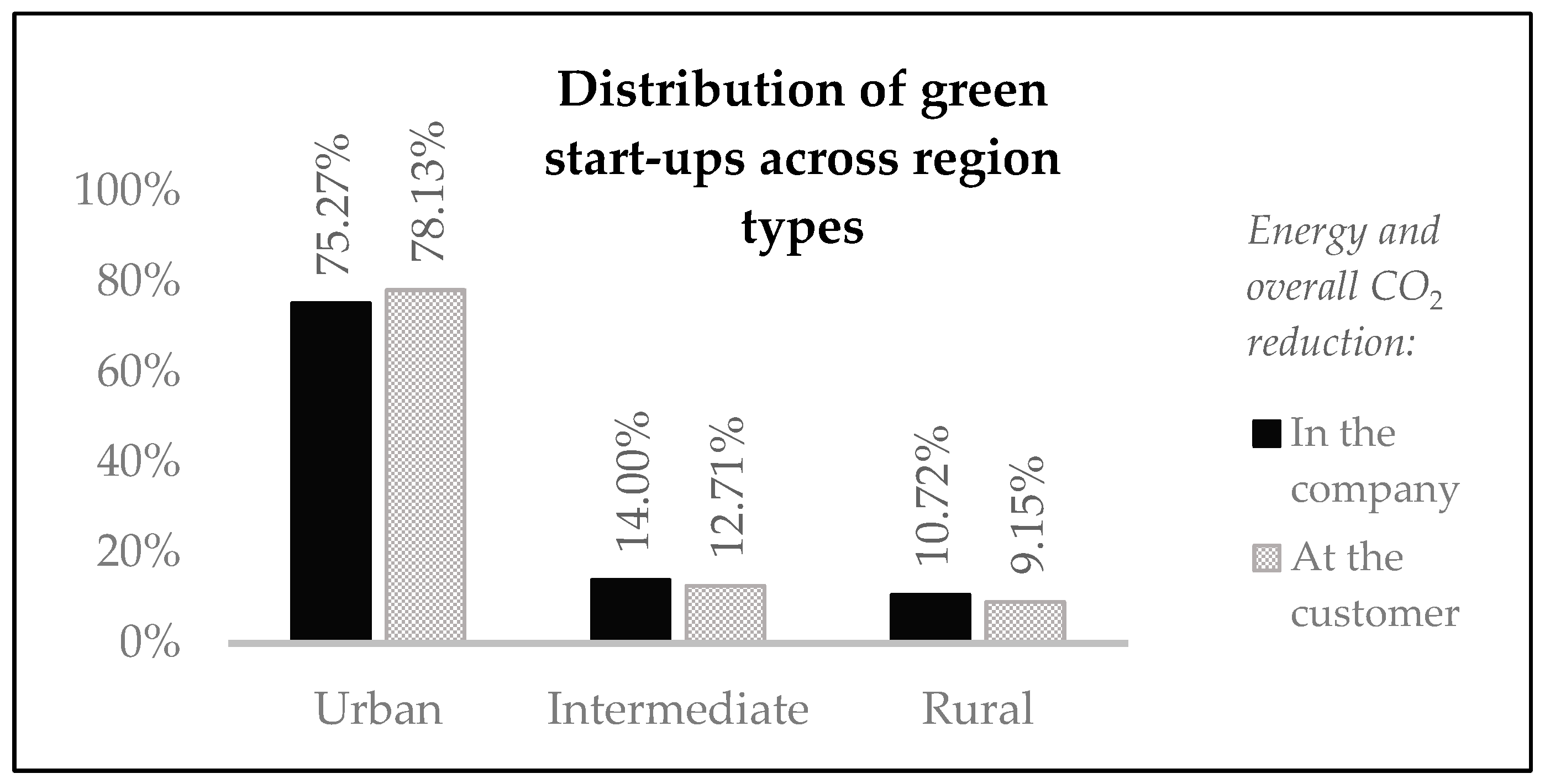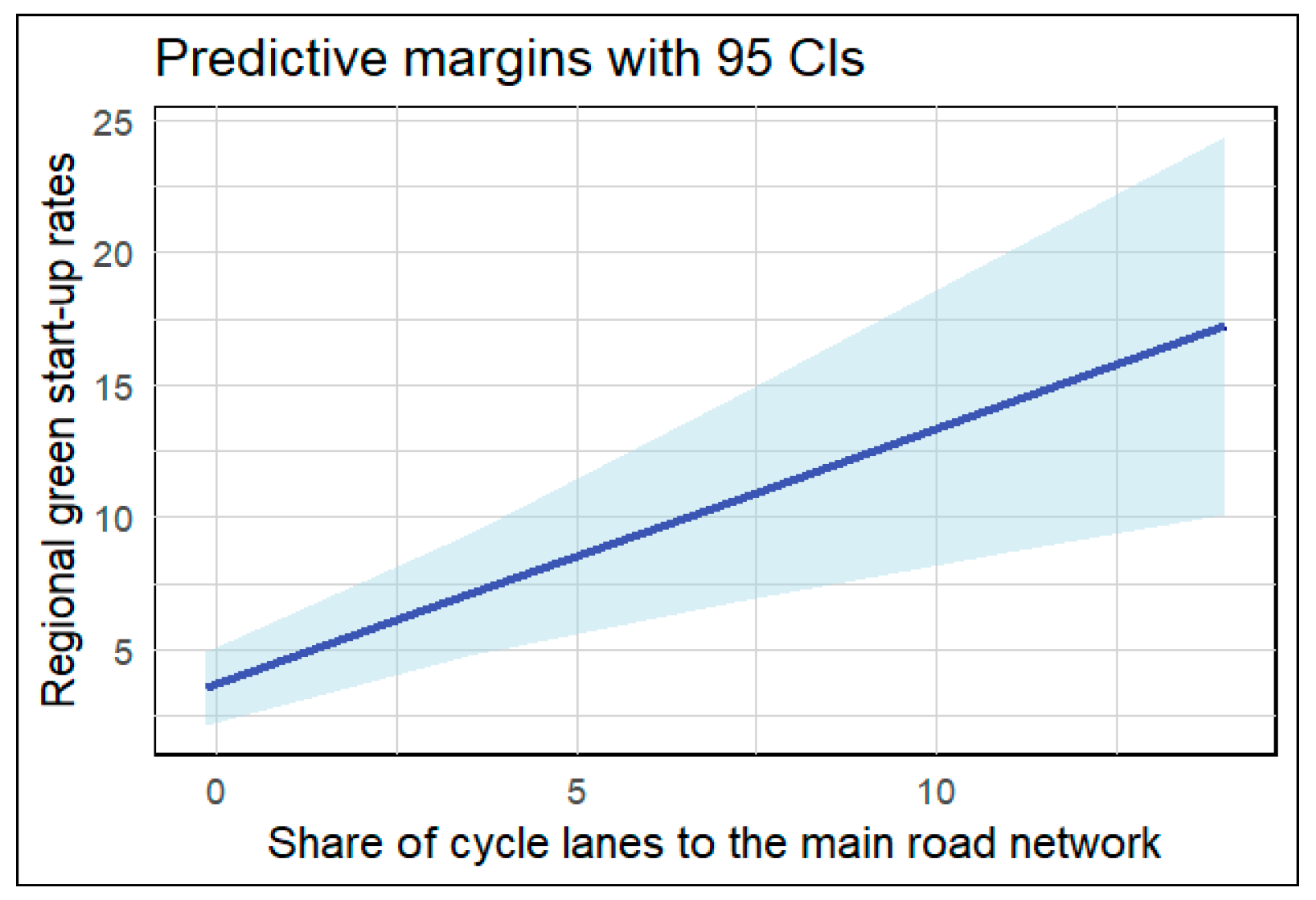Cycling as Critical Infrastructure for Green Start-Ups: A Multilevel Analysis in Germany
Abstract
1. Introduction
2. Literature Review
2.1. Definition of Sustainable Entrepreneurship
2.1.1. Defining Green (Eco-)Start-Ups
- Product-related characteristics—Do the start-up’s products (goods or services) align with environmental goals? This includes areas like renewable energy, resource efficiency, circular economy, waste management, emission reduction, and biodiversity protection.
- Entrepreneur-related characteristics—How do entrepreneurs themselves shape the greenness of their start-ups? This involves their motivation [10], values [22], and attitudes [23] on environmental issues in the business. Additionally, the environmental-related qualifications and knowledge of the entrepreneur can be considered relevant [24].
- Strategy-related characteristics—How can strategy through (continuous) interaction with external stakeholders strengthen or weaken the greenness of the start-up? This is decided by external stakeholders, such as investors, suppliers, and customers.
2.2. The Current State of the Art: Sustainable Entrepreneurial Ecosystems (SEEs)
2.2.1. Cycling as Critical Infrastructure for Green Start-Ups
2.2.2. Cycling and the Connection to the Wider Ecosystem
3. Materials and Methods
3.1. Firm-Level Data
3.1.1. Dependent Variables
- The first dependent variable measures the number of start-ups that significantly reduced energy consumption and/or the overall CO2 balance in the company at the regional (NUTS-3) level;
- The second dependent variable measures the number of start-ups that significantly reduced energy consumption and/or the overall CO2 balance on the customer side at the regional (NUTS-3) level.
3.1.2. Sample
3.2. Region-Level Data
3.2.1. Measurement of Cycling Infrastructure
3.2.2. Controlling for Other Modes of Transportation
3.2.3. Controlling for Quality of Life
- Population-employment density (measured by the population and employees at the workplace per km2);
- Population growth (measured in percentage over five years);
- Amenities (measured by the proportion of inhabitants with a max. 1000 m distance to the nearest supermarket or discounter);
- Creative class (measured by the percentage of employees in the creative and cultural industries).
3.2.4. Measurement of Entrepreneurial Ecosystems (EEs)
3.2.5. Controlling for the Regional Business Structure
3.3. Classification of Region Types
3.4. Model
- Yij is the number of green start-ups for i-region in the j-region type;
- β0 is the fixed intercept, representing the overall baseline rate of green start-ups;
- is the summation of K predictor variables (Xik) for the i-region, each with its fixed effect coefficient βk;
- Q is the coefficient of the interaction term, capturing how the effect of Xi1 on Yij changes depending on Zj;
- uj is the random intercept for the j-region type, capturing deviations of the j-region type’s intercept from the overall intercept β0;
- ϵij is the residual error term for the i-region within the j-region type, capturing deviations of observed Yij from the predicted value after accounting for fixed and random effects.
3.5. Descriptive Statistics
4. Results
4.1. Fixed Effects
4.1.1. Cycling Infrastructure
4.1.2. Cycling Infrastructure in the Connection to the Wider Ecosystem
5. Conclusions and Discussion
Limitations and Future Research
Funding
Institutional Review Board Statement
Informed Consent Statement
Data Availability Statement
Conflicts of Interest
Appendix A
| (a) | ||||
|---|---|---|---|---|
| Descriptive Statistics | Mean | St. Dev. | Min | Max |
| Firm size (employees) (mean) | 0 | 1 | −0.68 | 15.785 |
| Firm size (turnover) (mean) | 0 | 1 | −0.051 | 19.698 |
| In-house R&D (mean) | 0 | 1 | −0.614 | 7.354 |
| Manufacturing industries (mode) | 0.697 | 0.46 | 0 | 1 |
| Firm age (mean) | 0 | 1 | −2.969 | 4.658 |
| Creative class | 0 | 1 | −0.987 | 6.347 |
| Amenities | 0 | 1 | −1.551 | 3.303 |
| Population-employment density | 0 | 1 | −0.682 | 6.288 |
| Population growth | 0 | 1 | −3.278 | 3.385 |
| Public transportation | 0 | 1 | −0.758 | 11.036 |
| Cycle lanes | 0 | 1 | −0.146 | 14.488 |
| Entrepreneurial ecosystems (EEs) (PCA) | 0 | 1 | −7.035 | 1.451 |
| Region type | 1.703 | 0.835 | 1 | 3 |
| (b) | ||||
| Descriptive Statistics | VIF | |||
| Firm size (employees) (mean) | 1.058 | |||
| Firm size (turnover) (mean) | 1.016 | |||
| In-house R&D (mean) | 1.107 | |||
| Manufacturing industries (mode) | 1.064 | |||
| Firm age (mean) | 1.111 | |||
| Creative class | 1.682 | |||
| Amenities | 3.002 | |||
| Population-employment density | 2.224 | |||
| Population growth | 1.195 | |||
| Public transportation | 1.708 | |||
| Cycle lanes | 1.039 | |||
| Entrepreneurial ecosystems (EEs) (PCA) | 1.481 | |||
References
- Fishman, E. Bikeshare: A review of recent literature. Transp. Rev. 2016, 36, 92–113. [Google Scholar] [CrossRef]
- Pucher, J.; Buehler, R. Walking and cycling for healthy cities. Built Environ. 2010, 36, 391–414. [Google Scholar] [CrossRef]
- Audretsch, D.B.; Heger, D.; Veith, T. Infrastructure and entrepreneurship. Small Bus. Econ. 2015, 44, 219–230. [Google Scholar] [CrossRef]
- Audretsch, D.B.; Belitski, M. Entrepreneurial ecosystems in cities: Establishing the framework conditions. J. Technol. Transf. 2017, 42, 1030–1051. [Google Scholar] [CrossRef]
- Stam, E.; Spigel, B. Entrepreneurial Ecosystems; USE Discussion Paper Series; Utrecht University: Utrecht, The Netherlands, 2016. [Google Scholar]
- Audretsch, D.B.; Belitski, M. Towards an entrepreneurial ecosystem typology for regional economic development: The role of creative class and entrepreneurship. Reg. Stud. 2021, 55, 735–756. [Google Scholar] [CrossRef]
- Hechavarría, D.M.; Ingram, A.E. Entrepreneurial ecosystem conditions and gendered national-level entrepreneurial activity: A 14-year panel study of GEM. Small Bus. Econ. 2019, 53, 431–458. [Google Scholar] [CrossRef]
- Miles, M.P.; Morrison, M. An effectual leadership perspective for developing rural entrepreneurial ecosystems. Small Bus. Econ. 2020, 54, 933–949. [Google Scholar] [CrossRef]
- Leendertse, J.; Schrijvers, M.; Stam, E. Measure twice, cut once: Entrepreneurial ecosystem metrics. Res. Policy 2022, 51, 104336. [Google Scholar] [CrossRef]
- Schaltegger, S.; Wagner, M. Sustainable entrepreneurship and sustainability innovation: Categories and interactions. Bus. Strategy Environ. 2011, 20, 222–237. [Google Scholar] [CrossRef]
- Volkmann, C.; Fichter, K.; Klofsten, M.; Audretsch, D.B. Sustainable entrepreneurial ecosystems: An emerging field of research. Small Bus. Econ. 2021, 56, 1047–1055. [Google Scholar] [CrossRef]
- Pankov, S.; Velamuri, V.K.; Schneckenberg, D. Towards sustainable entrepreneurial ecosystems: Examining the effect of contextual factors on sustainable entrepreneurial activities in the sharing economy. Small Bus. Econ. 2021, 56, 1073–1095. [Google Scholar] [CrossRef]
- DiVito, L.; Ingen-Housz, Z. From individual sustainability orientations to collective sustainability innovation and sustainable entrepreneurial ecosystems. Small Bus. Econ. 2021, 56, 1057–1072. [Google Scholar] [CrossRef]
- Bischoff, K. A study on the perceived strength of sustainable entrepreneurial ecosystems on the dimensions of stakeholder theory and culture. Small Bus. Econ. 2021, 56, 1121–1140. [Google Scholar] [CrossRef]
- Wagner, M.; Schaltegger, S.; Hansen, E.G.; Fichter, K. University-linked programmes for sustainable entrepreneurship and regional development: How and with what impact? Small Bus. Econ. 2021, 56, 1141–1158. [Google Scholar] [CrossRef]
- Wurth, B.; Stam, E.; Spigel, B. Toward an entrepreneurial ecosystem research program. Entrep. Theory Pract. 2022, 46, 729–778. [Google Scholar] [CrossRef]
- IAB/ZEW Start-up Panel, IAB and ZEW, Nürnberg and Mannheim, Germany. 2021. Available online: https://www.gruendungspanel.de/en/zew-start-up-panel/home (accessed on 20 October 2022).
- Rosário, A.T.; Raimundo, R.J.; Cruz, S.P. Sustainable entrepreneurship: A literature review. Sustainability 2022, 14, 5556. [Google Scholar] [CrossRef]
- Muñoz, P.; Cohen, B. Sustainable entrepreneurship research: Taking stock and looking ahead. Bus. Strategy Environ. 2018, 27, 300–322. [Google Scholar] [CrossRef]
- Bergset, L.; Fichter, K. Green start-ups—A new typology for sustainable entrepreneurship and innovation research. J. Innov. Manag. 2015, 3, 118–144. [Google Scholar] [CrossRef]
- Schumpeter, J.A. The Theory of Economic Development; Harvard University Press: Cambridge, MA, USA, 1934. [Google Scholar]
- Parrish, B.D. Sustainability-driven entrepreneurship: Principles of organization design. J. Bus. Ventur. 2010, 25, 510–523. [Google Scholar] [CrossRef]
- Kuckertz, A.; Wagner, M. The influence of sustainability orientation on entrepreneurial intentions—Investigating the role of business experience. J. Bus. Ventur. 2010, 25, 524–539. [Google Scholar] [CrossRef]
- Patzelt, H.; Shepherd, D.A. Recognizing opportunities for sustainable development. Entrep. Theory Pract. 2011, 35, 631–652. [Google Scholar] [CrossRef]
- Welter, F. Contextualizing entrepreneurship—Conceptual challenges and ways forward. Entrep. Theory Pract. 2011, 35, 165–184. [Google Scholar] [CrossRef]
- Stam, E.; Welter, F. Geographical contexts of entrepreneurship: Spaces, places and entrepreneurial agency. In The Psychology of Entrepreneurship; Routledge: London, UK, 2020; pp. 263–281. [Google Scholar]
- Stam, E.; Van de Ven, A. Entrepreneurial ecosystem elements. Small Bus. Econ. 2021, 56, 809–832. [Google Scholar] [CrossRef]
- Bischoff, K.; Volkmann, C.K. Stakeholder support for sustainable entrepreneurship—A framework of sustainable entrepreneurial ecosystems. Int. J. Entrep. Ventur. 2018, 10, 172–201. [Google Scholar] [CrossRef]
- Fichter, K.; Fuad-Luke, A.; Hjelm, O.; Klofsten, M.; Backman, M.; Bergset, L.; Bienkowska, D.; Clausen, J.; Geier, J.; Hirscher, A.L.; et al. SHIFTing the Support of Entrepreneurship in Eco-Innovation. SHIFT Project Summary; SHIFT: Helsinki, Finland, 2016. [Google Scholar]
- O’Shea, G.; Farny, S.; Hakala, H. The buzz before business: A design science study of a sustainable entrepreneurial ecosystem. Small Bus. Econ. 2021, 56, 1097–1120. [Google Scholar] [CrossRef]
- Woolley, J.L. The creation and configuration of infrastructure for entrepreneurship in emerging domains of activity. Entrep. Theory Pract. 2014, 38, 721–747. [Google Scholar] [CrossRef]
- Hickman, R.; Banister, D. Transport and the environment. In A Research Agenda for Transport Policy; Edward Elgar Publishing: Cheltenham, UK, 2019; pp. 25–33. [Google Scholar]
- Fishman, E. Cycling as transport. Transp. Rev. 2016, 36, 1–8. [Google Scholar] [CrossRef]
- Pucher, J.; Buehler, R. Cycling towards a more sustainable transport future. Transp. Rev. 2017, 37, 689–694. [Google Scholar] [CrossRef]
- Stucki, T. Success of start-up firms: The role of financial constraints. Ind. Corp. Chang. 2014, 23, 25–64. [Google Scholar] [CrossRef]
- Volker, J.M.B.; Handy, S. Economic impacts on local businesses of investments in bicycle and pedestrian infrastructure: A review of the evidence. Transp. Rev. 2021, 41, 401–431. [Google Scholar] [CrossRef]
- Speckemeier, L.; Tsivrikos, D. Green entrepreneurship: Should legislators invest in the formation of sustainable hubs? Sustainability 2022, 14, 7152. [Google Scholar] [CrossRef]
- Tiba, S.; van Rijnsoever, F.J.; Hekkert, M.P. Sustainability startups and where to find them: Investigating the share of sustainability startups across entrepreneurial ecosystems and the causal drivers of differences. J. Clean. Prod. 2021, 306, 127054. [Google Scholar] [CrossRef]
- Hudde, A. Educational differences in cycling: Evidence from German cities. Sociology 2022, 56, 909–929. [Google Scholar] [CrossRef]
- Pugh, R.; MacKenzie, N.G.; Jones-Evans, D. From ‘techniums’ to ‘emptiums’: The failure of a flagship innovation policy in Wales. Reg. Stud. 2018, 52, 1009–1020. [Google Scholar] [CrossRef]
- Lepoutre, J.; Justo, R.; Terjesen, S.; Bosma, N. Designing a global standardized methodology for measuring social entrepreneurship activity: The Global Entrepreneurship Monitor social entrepreneurship study. Small Bus. Econ. 2013, 40, 693–714. [Google Scholar] [CrossRef]
- European Cyclists’ Federation. ECF Tracker 2.0. 2024. Available online: https://www.ecf.com/en/resources/ecfs-cycling-infrastructure-tracker/ (accessed on 12 September 2023).
- Ton, D.; Duives, D.C.; Cats, O.; Hoogendoorn-Lanser, S.; Hoogendoorn, S.P. Cycling or walking? Determinants of mode choice in the Netherlands. Transp. Res. Part A Policy Pract. 2019, 123, 7–23. [Google Scholar] [CrossRef]
- Pucher, J.; Buehler, R. Integrating bicycling and public transport in North America. J. Public Transp. 2009, 12, 79–104. [Google Scholar] [CrossRef]
- Bundesinstitut für Bau-, Stadt- und Raumforschung (BBSR). Raumgliederungen des BBSR. 2021. Available online: https://www.bbsr.bund.de/BBSR/DE/forschung/raumbeobachtung/Raumabgrenzungen/raumabgrenzungen-uebersicht.html (accessed on 9 September 2021).
- Mouratidis, K. Urban planning and quality of life: A review of pathways linking the built environment to subjective well-being. Cities 2021, 115, 103229. [Google Scholar] [CrossRef]
- Jacobs, J. The Death and Life of Great American Cities; Random House: New York, NY, USA, 1961. [Google Scholar]
- Greenacre, M.; Groenen, P.J.F.; Hastie, T.; d’Enza, A.I.; Markos, A.; Tuzhilina, E. Principal component analysis. Nat. Rev. Methods Primers 2022, 2, 100. [Google Scholar] [CrossRef]
- European Commission. Regional Competitiveness Index 2.0—2022 Edition. European Union, n.d. 2022. Available online: https://ec.europa.eu/regional_policy/information-sources/maps/regional-competitiveness_en (accessed on 7 April 2024).
- Bundesinstitut für Bau-, Stadt- und Raumforschung (BBSR). Indikatoren und Karten zur Raum- und Stadtentwicklung. INKAR. 2021. Available online: https://www.inkar.de/ (accessed on 17 November 2021).
- Riandita, A.; Broström, A.; Cagliano, R. Partnering with green start-ups: A vehicle for eco-innovation? Ind. Innov. 2025, 32, 24–52. [Google Scholar] [CrossRef]
- Hörisch, J.; Kollat, J.; Brieger, S.A. Environmental orientation among nascent and established entrepreneurs: An empirical analysis of differences and their causes. Int. J. Entrep. Ventur. 2019, 11, 373–393. [Google Scholar] [CrossRef]
- Hájek, P.; Stejskal, J. R&D cooperation and knowledge spillover effects for sustainable business innovation in the chemical industry. Sustainability 2018, 10, 1064. [Google Scholar] [CrossRef]
- Delgado-Gomes, V.; Oliveira-Lima, J.A.; Martins, J.F. Energy consumption awareness in manufacturing and production systems. Int. J. Comput. Integr. Manuf. 2017, 30, 84–95. [Google Scholar] [CrossRef]
- Mayer, H.; Habersetzer, A.; Meili, R. Rural–urban linkages and sustainable regional development: The role of entrepreneurs in linking peripheries and centers. Sustainability 2016, 8, 745. [Google Scholar] [CrossRef]
- Lopes, J.M.; Silva, L.F.; Massano-Cardoso, I.; Galhardo, A. Green Purchase Determinants in a Rural Region of Europe: How can green marketing influence consumers’ decisions? The mediating role of green awareness of price. Adm. Sci. 2024, 14, 293. [Google Scholar] [CrossRef]
- Theodoraki, C. Building entrepreneurial ecosystems sustainably. Found. Trends Entrep. 2024, 20, 384–480. [Google Scholar] [CrossRef]
- Hull, A.; O’Holleran, C. Bicycle Infrastructure: Can Good Design Encourage Cycling? Urban Plan. Transp. Res. 2014, 2, 369–406. [Google Scholar] [CrossRef]
- Helferich, M.; Tröger, J.; Dütschke, E. The role of automobility engagement for car use and car use reduction intentions in Germany. Transp. Res. Part F Traffic Psychol. Behav. 2024, 106, 199–214. [Google Scholar] [CrossRef]





| Indicators | Definition | Measurement in Time <> | NUTS Level | Source and Data Availability <> |
|---|---|---|---|---|
| Formal institutions | The rules and regulations in society | Quality of Government Index based on the level of corruption, unaccountability, and impartiality <2021> | NUTS-2 | Quality of Government Index by the Quality of Government Institute (University of Gothenburg) in the RCI (2022) [49] |
| Entrepreneurial culture | The extent to which entrepreneurship is appreciated in society | Percentage of self-employed per 100 members of the workforce <2020> | NUTS-3 | Ongoing spatial monitoring of the BBSR (2000–2023) [50] |
| Networks | The connectedness of businesses for new value creation | Percentage of SMEs with innovation cooperation activities <2021> | NUTS-2 | Regional Innovation Scoreboard (DG GROW) in the RCI (2022) [49] |
| Market demand | The availability of financial resources within the population to purchase goods and services | GDP per capita <2020> | NUTS-3 | Ongoing spatial monitoring of the BBSR (2000–2023) [50] |
| Intermediaries | Services that facilitate the creation, development, and growth of new businesses | Indirect federal grants for R&D projects in 1000 EUR per member of the working-age population <2017> | NUTS-3 | Ongoing spatial monitoring of the BBSR (1991–2017) [50] |
| Talent | The skills, knowledge, and experience held by individuals | Percentage of students at universities and universities of applied sciences per 1000 inhabitants <2020> | NUTS-3 | Ongoing spatial monitoring of the BBSR (2006–2021) [50] |
| Knowledge | Investments in knowledge (both scientific and technological) | Intramural R&D expenditure as % of GDP <2019> | NUTS-2 | Eurostat, Regional Science and Technology Statistics in the RCI (2022) [49] |
| Leadership | The presence of leaders that guide and direct collective action | EU research framework program H2020 in 1000 EUR per member of the working-age population <2017> | NUTS-3 | Ongoing spatial monitoring of the BBSR (2014–2017) [50] |
| Finance | The presence of financial means to invest in business activities | Percentage of start-ups that received external financial support in loans, venture capital, or funds at least once <2018–2020> | NUTS-3 | IAB/ZEW Start-up Panel (2021) [17] |
| Descriptive Statistics | Mean | St. Dev. | Min | Max |
|---|---|---|---|---|
| Firm size (employees) (mean) | 3.324 | 4.889 | 0.000 | 80.500 |
| Firm size (turnover) (mean) | 7.871 × 1011 | 1.554 × 1013 | 0.000 | 3.070 × 1014 |
| In-house R&D (mean) | 15,406.750 | 25,099.650 | 0.000 | 200,000.000 |
| Manufacturing industries (mode) | 0.697 | 0.460 | 0.000 | 1.000 |
| Firm age (mean) | 2.076 | 0.699 | 0.000 | 5.333 |
| Creative class | 2.520 | 2.132 | 0.415 | 16.048 |
| Amenities | 1177.731 | 547.731 | 328.000 | 2987.000 |
| Population-employment density | 794.764 | 1094.981 | 47.660 | 7679.780 |
| Population growth | 0.857 | 2.277 | −6.609 | 8.565 |
| Public transportation | 583.267 | 579.462 | 144.000 | 6978.000 |
| Cycle lanes | 8.482 | 58.104 | 0.000 | 850.310 |
| Entrepreneurial ecosystems (EEs) (PCA) | 0.000 | 0.728 | −5.123 | 1.056 |
| Region type | 1.703 | 0.835 | 1.000 | 3.000 |
| Pairwise t-Tests (Bonferroni) | Urban | Intermediate |
|---|---|---|
| Urban | - | 3.3 × 10−5 *** |
| Intermediate | 3.3 × 10−5 *** | - |
| Rural | 1.7 × 10−8 *** | 0.84 |
| Pairwise t-Tests (Bonferroni) | Urban | Intermediate |
|---|---|---|
| Urban | - | 4.1 × 10−6 *** |
| Intermediate | 4.1 × 10−6 *** | - |
| Rural | 1.3 × 10−9 *** | 0.87 |
| Fixed Effects | ||||
|---|---|---|---|---|
| Estimate | Std. Error | t Value | Pr (>|t|) | |
| (Intercept) | 2.261 | 0.389 | 5.810 | 0.004 |
| Firm size (employees) (mean) | −0.070 | 0.151 | −0.464 | 0.643 |
| Firm size (turnover) (mean) | 0.060 | 0.149 | 0.404 | 0.686 |
| In-house R&D (mean) | 0.220 | 0.155 | 1.418 | 0.157 |
| Manufacturing industries (mode) | 0.274 | 0.338 | 0.811 | 0.418 |
| Firm age (mean) | 0.140 | 0.152 | 0.921 | 0.358 |
| Creative class | 0.867 | 0.193 | 4.480 | 0.000 |
| Amenities | 0.376 | 0.261 | 1.443 | 0.150 |
| Population-employment density | 1.497 | 0.220 | 6.816 | 0.000 |
| Population growth | 0.077 | 0.162 | 0.478 | 0.633 |
| Public transportation | −0.078 | 0.196 | −0.399 | 0.690 |
| Entrepreneurial ecosystems (EEs) (PCA) | 0.733 | 0.183 | 4.001 | 0.000 |
| Cycle lanes | 0.578 | 0.152 | 3.810 | 0.000 |
| EEs X Cycle lanes | 0.077 | 0.148 | 0.519 | 0.604 |
| Random variance | 0.218 | 0.127 | ||
| Likelihood Ratio Test (Chisq) | 134.59 | <2.2 × 10−16 | ||
| AIC | 1981.8 |
| Fixed Effects | ||||
|---|---|---|---|---|
| Estimate | Std. Error | t Value | Pr (>|t|) | |
| (Intercept) | 3.519 | 0.817 | 4.306 | 0.021 |
| Firm size (employees) (mean) | −0.073 | 0.253 | −0.287 | 0.774 |
| Firm size (turnover) (mean) | 0.134 | 0.248 | 0.538 | 0.591 |
| In-house R&D (mean) | 0.368 | 0.260 | 1.417 | 0.157 |
| Manufacturing industries (mode) | 0.237 | 0.564 | 0.420 | 0.675 |
| Firm age (mean) | 0.148 | 0.254 | 0.585 | 0.559 |
| Creative class | 1.078 | 0.324 | 3.332 | 0.001 |
| Amenities | 0.670 | 0.437 | 1.533 | 0.126 |
| Population-employment density | 2.479 | 0.367 | 6.757 | 0.000 |
| Population growth | 0.104 | 0.271 | 0.383 | 0.702 |
| Public transportation | −0.103 | 0.329 | −0.314 | 0.753 |
| Entrepreneurial ecosystems (EEs) (PCA) | 1.169 | 0.307 | 3.810 | 0.000 |
| Cycle lanes | 0.968 | 0.253 | 3.819 | 0.000 |
| EEs X Cycle lanes | 0.241 | 0.247 | 0.976 | 0.330 |
| Random variance | 1.341 | 0.009 | ||
| Likelihood Ratio Test (Chisq) | 137.3 | <2.2 × 10−16 | ||
| AIC | 2372.7 |
Disclaimer/Publisher’s Note: The statements, opinions and data contained in all publications are solely those of the individual author(s) and contributor(s) and not of MDPI and/or the editor(s). MDPI and/or the editor(s) disclaim responsibility for any injury to people or property resulting from any ideas, methods, instructions or products referred to in the content. |
© 2025 by the author. Licensee MDPI, Basel, Switzerland. This article is an open access article distributed under the terms and conditions of the Creative Commons Attribution (CC BY) license (https://creativecommons.org/licenses/by/4.0/).
Share and Cite
Meijering, B. Cycling as Critical Infrastructure for Green Start-Ups: A Multilevel Analysis in Germany. Sustainability 2025, 17, 3441. https://doi.org/10.3390/su17083441
Meijering B. Cycling as Critical Infrastructure for Green Start-Ups: A Multilevel Analysis in Germany. Sustainability. 2025; 17(8):3441. https://doi.org/10.3390/su17083441
Chicago/Turabian StyleMeijering, Blom. 2025. "Cycling as Critical Infrastructure for Green Start-Ups: A Multilevel Analysis in Germany" Sustainability 17, no. 8: 3441. https://doi.org/10.3390/su17083441
APA StyleMeijering, B. (2025). Cycling as Critical Infrastructure for Green Start-Ups: A Multilevel Analysis in Germany. Sustainability, 17(8), 3441. https://doi.org/10.3390/su17083441






